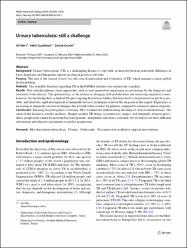| dc.contributor.author | Mert, Ali | |
| dc.contributor.author | Güzelburç, Vahit | |
| dc.contributor.author | Güven, Selçuk | |
| dc.date.accessioned | 2020-12-03T08:06:49Z | |
| dc.date.available | 2020-12-03T08:06:49Z | |
| dc.date.issued | 2020 | en_US |
| dc.identifier.citation | Mert, A., Güzelburç, V. ve Güven, S. (2020). Urinary tuberculosis: Still a challenge. World Journal of Urology, 38(11), 2693-2698. https://dx.doi.org/10.1007/s00345-020-03146-7 | en_US |
| dc.identifier.issn | 0724-4983 | |
| dc.identifier.issn | 1433-8726 | |
| dc.identifier.uri | https://dx.doi.org/10.1007/s00345-020-03146-7 | |
| dc.identifier.uri | https://hdl.handle.net/20.500.12511/6076 | |
| dc.description.abstract | Background Urinary tuberculosis (TB) is a challenging disease to cope with, as there has been no noticeable difference in basic diagnostic and therapeutic options in clinical practice over time. Purpose The aim of the current review was the critical assessment and evaluation of TB, which remains a major global health problem. Methods The available literature regarding TB in the PubMed database was extensively searched. Results New interdisciplinary team approaches such as next-generation sequencing are promising for the diagnosis and treatment of the disease. The epidemiology of the disease is changing with globalization and increasing migration events; however, the knowledge here is limited. Despite ongoing destruction, kidney functions need to be preserved as much as possible, and relatively rapid development of minimally invasive techniques relieved the surgeons in this regard. Experience is increasing in minimally invasive techniques that provide better comfort for patients compared to extensive radical surgeries. Conclusions Knowing the pathogenesis of urinary TB is essential for understanding the range of clinical manifestations. The onset of the disease is usually insidious. Despite modern TB drugs, reconstructive surgery, and minimally invasive procedures, progression cannot be prevented in some patients, and patient selection is essential, but we still do not have sufficient information and objective parameters to predict progression. | en_US |
| dc.language.iso | eng | en_US |
| dc.publisher | Springer | en_US |
| dc.rights | info:eu-repo/semantics/embargoedAccess | en_US |
| dc.subject | Mycobacterium Tuberculosis | en_US |
| dc.subject | Urinary | en_US |
| dc.subject | Endoscopic | en_US |
| dc.subject | Reconstructive or Ablative Surgical Interventions | en_US |
| dc.title | Urinary tuberculosis: Still a challenge | en_US |
| dc.type | article | en_US |
| dc.relation.ispartof | World Journal of Urology | en_US |
| dc.department | İstanbul Medipol Üniversitesi, Tıp Fakültesi, Dahili Tıp Bilimleri Bölümü, Enfeksiyon Hastalıkları ve Klinik Mikrobiyoloji Ana Bilim Dalı | en_US |
| dc.department | İstanbul Medipol Üniversitesi, Tıp Fakültesi, Cerrahi Tıp Bilimleri Bölümü, Üroloji Ana Bilim Dalı | en_US |
| dc.authorid | 0000-0001-8945-2385 | en_US |
| dc.authorid | 0000-0001-9988-2944 | en_US |
| dc.authorid | 0000-0002-5009-8435 | en_US |
| dc.identifier.volume | 38 | en_US |
| dc.identifier.issue | 11 | en_US |
| dc.identifier.startpage | 2693 | en_US |
| dc.identifier.endpage | 2698 | en_US |
| dc.relation.publicationcategory | Makale - Uluslararası Hakemli Dergi - Kurum Öğretim Elemanı | en_US |
| dc.identifier.doi | 10.1007/s00345-020-03146-7 | en_US |
| dc.identifier.wosquality | Q1 | en_US |
| dc.identifier.scopusquality | Q1 | en_US |


















